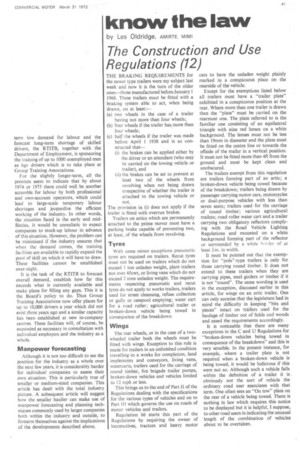know the law
Page 43

If you've noticed an error in this article please click here to report it so we can fix it.
by Les Oldridge, AMIRTE, MIMI
The Construction and Use Regulations (12)
THE BRAKING REQUIREMENTS for the newer type trailers were my subject last week and now it is the turn of the older ones—those manufactured before January 1 1968. These trailers must be fitted with a braking system able to act, when being -drawn, on at least ;— (a) two wheels in the case of a trailer having not more than four wheels; (b) four wheels if the trailer has more than four wheels; (c) half the wheels if the trailer was made before April 1 1938 and is so constructed that (i) the brakes can be applied either by the driver or an attendant (who may be carried on the towing vehicle or trailer), and (ii) the brakes can be set to prevent at least two of the wheels from revolving when not being drawn irrespective of whether the trailer is attached to the towing vehicle or t.
The provision in (i) does not apply if the trailer is fitted with overrun brakes.
Trailers on artics which are permanently attached to the prime mover must have a parking brake capable of preventing two, at least, of the wheels from revolving.
Tyres
With some minor exceptions pneumatic tyres are required on trailers. Recut tyres must not be used on trailers which do not exceed 1 ton unladen weight, plant trailers not over 45cwt, or living vans which do not exceed 2 tons unladen weight. The requirements respecting pneumatic and recut tyres do not apply to works trailers, trailers used for street cleansing, refuse collection or gully or cesspool emptying; water cart for a road roller; agricultural trailer or broken-down vehicle being towed in consequence of the breakdown.
Wings
The rear wheels, or in the case of a twowheeled trailer both the wheels must be fitted with wings. Exception to this rule is made for trailers in an unfinished condition travelling to a works for completion, land implements and conveyors, living vans, watercarts, trailers used for the carriage of round timber, fire brigade trailer pumps, broken-down vehicles and vehicles limited to 12 mph or less.
This brings us to the end of Part II of the Regulations dealing with the specifications for the various types of vehicles and on to Part 111 which governs the use on roads of motor vehicles and trailers.
Regulation 66 starts this part of the Regulations by requiring the owner of locomotives, tractors and heavy motor cars to have the unladen weight plainly marked in a conspicuous place on the nearside of the vehicle.
Except for the exemptions listed below all trailers must have a "trailer plate" exhibited in a conspicuous position at the rear. Where more than one trailer is drawn then the "plate" must be carried on the rearmost one. The plate referred to is the familiar one consisting of an equilateral triangle with nine red lenses on a white background. The lenses must not be less than 19mm in diameter and the plate must be fitted on the centre line or towards the offside of the trailer in a vertical position. It must not be fitted more than 4ft from the ground and must be kept clean and unobscured.
The trailers exempt from this regulation are trailers forming part of an artic; a broken-down vehicle being towed because of the breakdown; trailers being drawn by passenger carrying motor cars, motorcycles or dual-purpose vehicles with less than seven seats; trailers used for the carriage of round timber; various agricultural trailers; road roller water cart and a trailer carrying two obligatory reflectors complying with the Road Vehicle Lighting Regulations and mounted on a white background forming part of the reflector or surrounded by a white HArder of at least Dn, in width.
It must be pointed out that the exemption for "pole"-type trailers is only for those carrying round timber. It does not extend to these trailers when they are carrying pipes, steel girders or timber if it is not "round". The same wording is used in the exception, discussed earlier in this article, for wings on an artic trailer. One can only surmise that the legislature had in mind the difficulty in keeping "bits and pieces" intact on trailers used for the haulage of timber out of fields and woods and eased the requirements accordingly.
It is noticeable that there are many exceptions in the C and U Regulations for "broken-down vehicles being towed in consequence of the breakdown" and this is very sensible. In the present instance, for example, where a trailer plate is not required when a broken-down vehicle is being towed, it would be ludicrous if this were not so. Although such a vehicle falls within the definition of a trailer it is , obviously not the sort of vehicle the ordinary road user associates with that term. One often sees an "On tow" plate on the rear of a vehicle being towed. There is nothing in law which requires this notice to be displayed but it is helpful, I suppose, to other road users in indicating the unusual length of the combination of vehicles about to be overtaken.




















































































